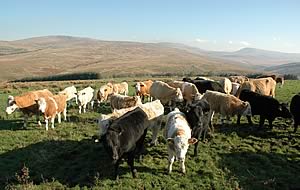 |
|||||||||
|
|||||||||||||||||||
|
|
Sticking with the Simmental 12/01/06
Cumbrian beef farmer Kevin Holliday maintains that weight pays and he has stuck with the Simmental which suits his hill farm. The Swiss breed was first introduced by Kevin and his wife Yvonne to Strudda Bank, Calderbridge, in West Cumbria, in 1992, and today half the 100-cow herd is pedigree Simmental with the remainder Simmental crosses. “The Simmental is a dual-purpose cow bred in the Swiss Alps with a stomach like a big fermentation vat which can handle large quantities of low quality roughage to produce both milk and meat - and they also have a good jacket,” says Kevin Holliday. “They are big, prolific cows which do the business.” He started farming on his own at Strudda Bank in 1986, running a herd of black Herefords. However, it was his godfather, Henry Pickering, who with a Nuffield Scholarship had studies European beef breeds, who was so impressed with the Simmental that he established the Brackenbury herd. “I listened a lot to Henry but it took his untimely death and sale of the Brackenbury herd to invest in a Simmental cow. My father Denis who was one of Henry's oldest friends commended my patronisation but commented that I could have bought four black Hereford cows for that price! “My thoughts then and now were I had bought a good cow with a personality, not an attitude problem - which sums up the Simmental breed.” The cow which cost the Hollidays 1,600gns was Brackenbury Rachel, an eight year old with her sixth calf at foot, and she went on to rear another six calves. Her daughters, grand daughters and great grand daughters are still in the herd and the longevity of the Simmental is one of its attributes with cows going on to produce up to 15 calves. The long-lived cows more than pay-back the costs of their first three years until they produce their first calf and their superior breeding qualities are naturally selected - the older the cow the better breeder she is. “They hatch without you seeing them and they milk well and their calves grow,” said Kevin. Kevin and Yvonne own 400 acres of SDA land and they rent a further 100 acres of similar type ground, having commons rights on Cold Fell and Kinniside Common. Heifers are calved at two years old if they are above 450kg and commercial calves are sold at six and 12 months old. Alongside the cattle, they run 450 Swaledales, 250 of which are put to the Bluefaced Leicester with 150 bred pure. There are also 400 Herdwicks, 150 of which are bred pure with 250 put to the Texel and 200 North Country Cheviots, with 150 bred pure and 50 put to the Border Leicester. Their family - Vicky, 19, Becky, 15 and Martin, 13, take a keen interest in the farm. With the first pedigree cow bought, the Hollidays needed a bull to establish their herd and to cross with the commercial cattle. The supreme champion from Ralph Lloyd at the spring 1993 Carlisle sale, Grayrigg Bigun, a big, well-fleshed bull out of Stuartslaw Joseph, caught Kevin's eye and he bought him for 2,600gns. With commercial calves getting results in the local auction, the Hollidays invested in their second pedigree Simmental, Heywood Token a “gentle giant” and stock bull bought at the Barbon dispersal sale in Carlisle in November 1994 for 1,100gns. Within a couple of years Token and Bigun had made their mark and almost all the cattle were Simmental sired. The cattle adapted well to the flora and fauna of the SDA, producing good milking and mothering cows with a good temperament with excellent beefing and weight gains in calves. Kevin Holliday was quick to recognise the benefits of recording, apart from producing figures for pedigree animals, - in being able to fine-tune rations and forage and monitor the results of bought-in concentrate feed as well as giving a sense of achievement, particularly during the winter months. The purchase of a crush with a set of scales was a good investment that Kevin would recommend to anyone. All young cattle are weighed at housing and then on a monthly basis until turnout. They are also weighed in mid summer. It was a home-bred bull which next made a significant impact on the herd. Strudda Bank Hornet, a son of Brinkton Brilliant, performed excellently and could match and beat the Signet semen sent to benchmark the herd. However, with so many daughters in the herd, Hornet was reluctantly sold at Mitchells in Cockermouth. When in the ring with the bull, Kevin Holliday spoke too soon to say “Never jumped a dyke in his life” at which point the bull nearly cleared the railings of the ring in a bid to get to cows in the mart. The evidence was caught on camera and the action photo of the bull, which sold to Steels of the Dubbs, hangs on auctioneer Adam Day's office wall! The next bull to fit the Strudda Bank herd's qualities was purchased at the Perth October 2004 sale, and, following Waxhall Field Marshall and Starline Klassic lines, the Hollidays bought Starline Paratrooper to bring him into use the following spring. His first calves a set of twins were born in August this year, rapidly followed by a further 10. The spring calving heifers have been PD-ed with 19 out of 20 in calf, the geld one being a freemartin. © Copyright 2005 Jennifer MacKenzie All Rights Reserved. |
||||||||||||||||||

|
|
||||||||||||||||||
| home | agri-services | pedigree
pen | news | dairy | beef | machinery property | organisations | site map |
|||||||||||||||||||

Article by
Jennifer MacKenzie
